Research on Polar-Axis Direct Solar Radiation Spectrum Measurement Method
Abstract
1. Introduction
2. Overall Architecture and Measurement Principle of Polar-Axis Solar Direct Radiation Spectrum Measurement System
3. Joint Optimization Design of Solar Spectral Measurement System and Polar-Axis Rotating Mirror
4. Multi-Angle Response Analysis and Spectral Reconstruction Method for PADS
5. Accuracy Evaluation of Polar-Axis Direct Solar Radiation Measurement System Based on AM0 and AM1.5G Spectra
- (1)
- Assessment of the measurement accuracy of AM0 solar spectrum reconstruction
- (2)
- Assessment of measurement accuracy of AM1.5G solar spectrum reconstruction
- (3)
- Comparison of AM0 and AM1.5G solar spectrum accuracy assessment
6. Conclusions and Outlook
- (1)
- This study is the first to apply the polar-axis tracking method to the field of direct solar radiation spectrum measurement. It constructs the overall architecture of a polar-axis rotating direct solar radiation spectrum measurement system composed of a polar-axis rotating mirror and a Solar Spectral Measurement System, simplifies the structure of traditional direct solar radiation measurement systems, realizes direct solar radiation spectrum measurement without the need for mobile tracking throughout the year and across all latitudes, and further improves the theoretical system of direct solar radiation spectrum measurement.
- (2)
- The polar-axis rotating mirror and solar spectral measurement system were jointly optimized to achieve a spectral resolution of 2 nm in each field of view. This allows the solar beam reflected by the polar-axis rotating mirror to propagate freely within the system space to the solar spectral measurement system, reducing the constraints on measurement energy compared to the aperture.
- (3)
- Based on the design results of the polar-axis direct solar radiation spectrum measurement optical system, a direct solar radiation spectrum reconstruction model was established, with 13 angle light sources (−23.5°, −20°, −16°, −12°, −8°, −4°, 0°, 4°, 8°, 12°, 16°, 20°, and 23.5° (the spectral distribution is an equal energy spectrum)) to simulate the incident direct solar radiation, and the experimental results and reconstruction coefficients for each angle were obtained. Using the AM0 and AM1.5G solar spectra as examples, the performance parameters of the system were verified through simulation. The results show that the direct solar radiation spectrum distribution of the incident angle of direct sunlight at various angles after reconstruction is consistent with the AM0 and AM1.5G solar spectrum distribution. The point errors are distributed between −9.05% and 13.35% and −9.19% and 13.66%, respectively. However, the average errors were only 0.03% and 0.02%, indicating that individual points influenced the error intervals, with area errors ranging from −0.04% to 0.09% and −0.03% to 0.11%, respectively. The overall spectral shapes were highly similar, with spatio-temporal uniformity exceeding 99.92%.
Author Contributions
Funding
Institutional Review Board Statement
Informed Consent Statement
Data Availability Statement
Conflicts of Interest
References
- Tahir, Z.R.; Asim, M. Surface measured solar radiation data and solar energy resource assessment of Pakistan: A review. Renew. Sustain. Energy Rev. 2018, 81 Pt 2, 2839–2861. [Google Scholar] [CrossRef]
- Wang, Y.; Yuan, Q.; Li, T.; Zhu, L.; Zhang, L. Causes for Asymmetric Trends in Surface Solar Radiation over China: Emission Reduction and Meteorological Influence. Atmos. Chem. Phys. 2021, 21, 13383–13399. [Google Scholar]
- Khan, N.; Xu, X.; Ahsan, F. Solar empowerment in agriculture: Investigating photovoltaic energy’s impact on efficiency among wheat farmers. Front. Sustain. Food Syst. 2024, 8, 1426538. [Google Scholar] [CrossRef]
- Budiyanto, M.; Lubis, M. Physical reviews of solar radiation models for estimating global solar radiation in Indonesia. Energy Rep. 2020, 6, 1206–1211. [Google Scholar] [CrossRef]
- Opálková, M.; Navrátil, M.; Špunda, V.; Blanc, P.; Wald, L. A database of 10 min average measurements of solar radiation and meteorological variables in Ostrava, Czech Republic. Earth Syst. Sci. Data 2018, 10, 837–846. [Google Scholar] [CrossRef]
- Badgujar, U.; Badekar, A.; Shrangare, S.; Pathan, A.; Karale, P. Solar Tracking and Monitoring System. Int. J. Res. Appl. Sci. Eng. Technol. 2024, 12, 2315–2320. [Google Scholar] [CrossRef]
- Rajkumar, N.; Govindhavasan; Jeyasri; Kumar, A.; Mahilarasi, A. Solar Tracking Methods: A Comprehensive Survey. Int. J. Res. Appl. Sci. Eng. Technol. 2024, 12, 4361–4364. [Google Scholar] [CrossRef]
- García-Cabrera, R.D.; Cuevas-Agulló, E.; Barreto, Á.; Cachorro, V.E.; Pó, M.; Ramos, R.; Hoogendijk, K. Aerosol retrievals from the EKO MS-711 spectral direct irradiance measurements and corrections of the circumsolar radiation. Atmos. Meas. Tech. 2020, 13, 2601–2621. [Google Scholar] [CrossRef]
- Kuttybay, N.; Saymbetov, A.; Mekhilef, S.; Nurgaliyev, M.; Tukymbekov, D.; Dosymbetova, G.; Meiirkhanov, A.; Svanbayev, Y. Optimized Single-Axis Schedule Solar Tracker in Different Weather Conditions. Energies 2020, 13, 5226. [Google Scholar] [CrossRef]
- Wong, J.; Bai, F.; Saha, T.K.; Tan, R.H. A feasibility study of the 1.5-axis tracking model in utility-scale solar PV plants. Sol. Energy 2021, 216, 171–179. [Google Scholar] [CrossRef]
- Mamodiya, U.; Tiwari, N. Dual-axis solar tracking system with different control strategies for improved energy efficiency. Comput. Electr. Eng. 2023, 111, 108920. [Google Scholar] [CrossRef]
- Shang, H.; Shen, W. Design and Implementation of a Dual-Axis Solar Tracking System. Energies 2023, 16, 6330. [Google Scholar] [CrossRef]
- Barreto, Á.; Cuevas, E.; Granados-Muñoz, M.-J.; Alados-Arboledas, L.; Romero, P.M.; Gröbner, J.; Kouremeti, N.; Almansa, A.F.; Stone, T.; Toledano, C.; et al. The new sun-sky-lunar Cimel CE318-T multiband photometer—A comprehensive performance evaluation. Atmos. Meas. Tech. 2016, 9, 11077–11138. [Google Scholar] [CrossRef]
- Liu, J. Research on Ultraviolet Aerosol Optical Depth Based on Sky Radiometer. Ph.D. Thesis, Xi’an University of Technology, Xi’an, China, 2018. [Google Scholar]
- Tatsiankou, V.; Hinzer, K.; Schriemer, H.; Kazadzis, S.; Kouremeti, N.; Gröbner, J.; Beal, R. Extensive validation of solar spectral irradiance meters at the World Radiation Center. Sol. Energy 2018, 166, 80–89. [Google Scholar] [CrossRef]
- Qi, Z.; Li, J.; Xu, W.; Zhu, W.; Sun, F.; Huang, Y.; Xu, G.; Dai, C. Optomechanical Design and Application of Solar-Skylight Spectroradiometer. Sensors 2021, 21, 3751. [Google Scholar] [CrossRef]
- Flores-Hernández, D.A.; Luviano-Juárez, A.; Lozada-Castillo, N.; Gutiérrez-Frías, O.; Domínguez, C.; Antón, I. Optimal Strategy for the Improvement of the Overall Performance of Dual-Axis Solar Tracking Systems. Energies 2021, 14, 7795. [Google Scholar] [CrossRef]
- Lee, C.-Y.; Chou, P.-C.; Chiang, C.-M.; Lin, C.-F. Sun Tracking Systems: A Review. Sensors 2009, 9, 3875–3890. [Google Scholar] [CrossRef]
- Yang, X. Optimization design method of free-form surface reflector for direct solar radiation measurement. Acta Opt. Sin. 2022, 42, 0922001. [Google Scholar]
- Mo, X.; Zhang, J.; Wang, L.; Sun, J.; Yang, S.; Shi, H.; Zhang, Y.; Zhao, B.; Yang, J.; Zhang, G.; et al. Direct solar-radiation intensity measurement based on multiple off-axis hyperboloids fused with free-form surfaces. Opt. Express 2025, 33, 10777–10794. [Google Scholar] [CrossRef]
- Sun, J.; Zhang, J.; Mo, X.; Wang, L.; Zhao, B.; Zhang, Y.; Chong, W.; Liu, Q.; Zou, Y.; Ren, Z.; et al. Free-form surface-based polar-axis rotational direct solar radiation spectrum measurements. Opt. Express 2025, 33, 4176–4193. [Google Scholar] [CrossRef]
- Reda, I.; Andreas, A. Solar position algorithm for solar radiation applications. Sol. Energy 2004, 76, 577–589. [Google Scholar] [CrossRef]
- Shi, H.; Jiang, H.; Zhang, X.; Wang, C.; Liu, T. Analysis of nodal aberration properties in off-axis freeform system design. Appl. Opt. 2016, 55, 6782–6790. [Google Scholar] [CrossRef]
- Hu, P.-C.; Chang, D.; Tan, J.-B.; Yang, R.-T.; Yang, H.-X.; Fu, H.-J. Displacement measuring grating interferometer: A review. Front. Inf. Technol. Electron. Eng. 2019, 20, 631–654. [Google Scholar] [CrossRef]
- Zhang, Y.; Li, W.; Duan, W.; Huang, Z.; Yang, H. Echelle Grating Spectroscopic Technology for High-Resolution and Broadband Spectral Measurement. Appl. Sci. 2022, 12, 11042. [Google Scholar] [CrossRef]
- Shi, H.; Zhang, X.; Li, Y.; Li, Y.C.; Jiang, L.; Wang, C.; Liu, Z.; Jiang, H.L. Analysis of aberration characteristics in pupil off-axis freeform surface optical systems. Acta Opt. 2017, 37, 1208001. [Google Scholar]
- Jin, S.; Li, Z.; Feng, Z.; Gao, L.; Li, Y.; Zhang, L.; Shi, W.; Xia, G. Optical System Design of a Planar Waveguide Spectrometer. Coatings 2022, 12, 520. [Google Scholar] [CrossRef]
- Xia, C. Optical Design of a Portable Anastigmatic Czerny-Turner Spectrometer. Master’s Thesis, Soochow University, Suzhou, China, 2022. [Google Scholar] [CrossRef]
- Zhou, W.; Liu, Z.; Sun, Y.; Teng, H.; Wang, W.; Bayanheshig; Li, W. Bidirectional Littrow double grating interferometry for quadruple optical interpolation. Opt. Laser Technol. 2024, 175, 110751. [Google Scholar] [CrossRef]
- Kren, A.C.; Pilewskie, P.; Coddington, O. Where does earth’s atmosphere get its energy? J. Space Weather Space Clim. 2017, 7, A10. [Google Scholar] [CrossRef]
- Li, W. Controlling the wavefront aberration of a large-aperture and high-precision holographic diffraction grating. Light. Sci. Appl. 2025, 14, 112. [Google Scholar] [CrossRef] [PubMed]
- Zhou, W. A random angle error interference eliminating method for grating interferometry measurement based on symmetry littrow structure. Laser Photonics 2025, 19, 2401659. [Google Scholar] [CrossRef]
- Reader, J. Optimizing czerny–turner spectrographs: A comparison between analytic theory and ray tracing. J. Opt. Soc. Am. 1969, 59, 1189–1194. [Google Scholar] [CrossRef]
- Xu, G.; Ke, Z.; Zhuang, C.; Li, Y.; Cai, R.; Yang, Y.; Du, X. Measurements and analysis of solar spectrum in near space. Energy Rep. 2023, 9, 1764–1773. [Google Scholar] [CrossRef]
- Yang, J.; Zhang, G.; Zhao, B.; Yang, D.; Zhang, K.; Zhang, Y.; Zhang, J.; Ren, Z.; Sun, J.; Wang, L.; et al. Solar Spectrum Simulation Algorithms Considering AM0G and AM1.5G. Sensors 2025, 25, 1406. [Google Scholar] [CrossRef]
- World Meteorological Organization. Guide to Meteorological Instruments and Methods of Observation, 2017 ed.; WMO-No. 8; WMO: Geneva, Switzerland, 2017; Available online: https://library.wmo.int/index.php?lvl=notice_display&id=12407 (accessed on 20 May 2024).
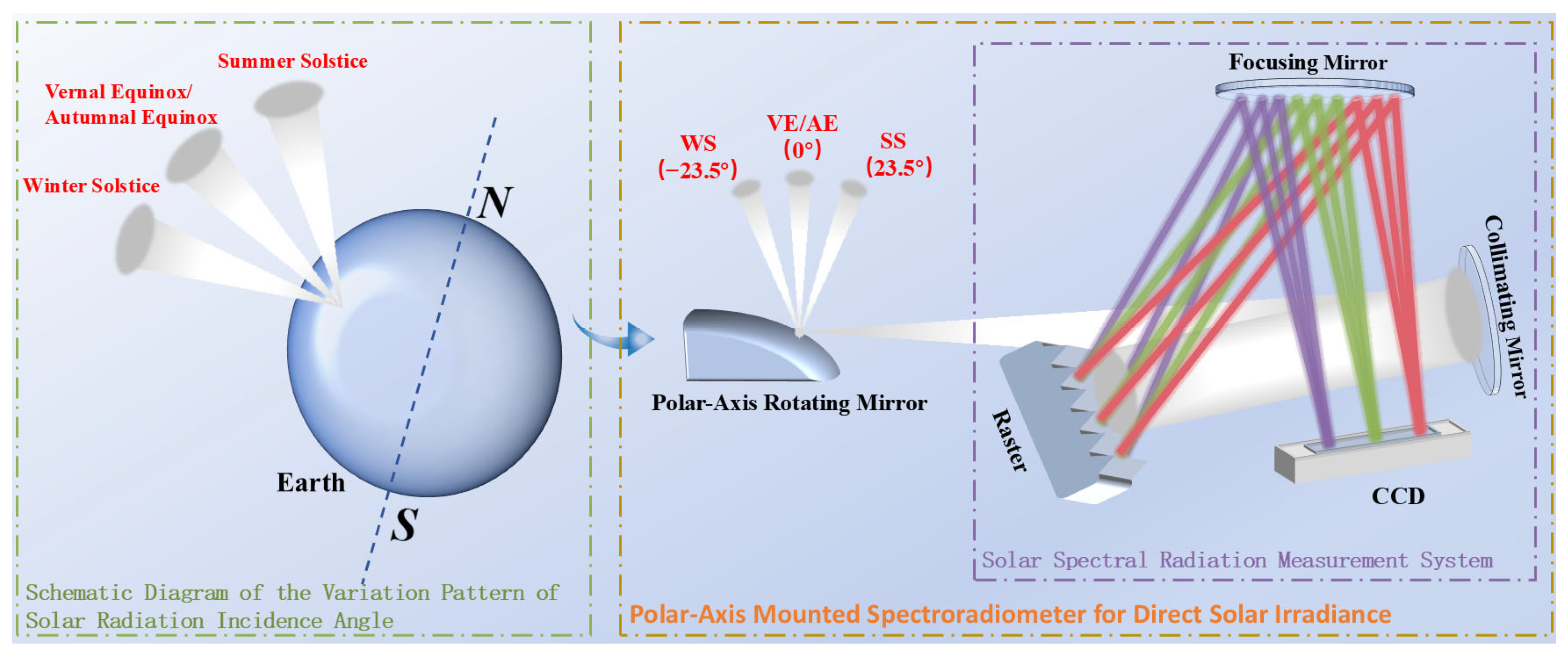
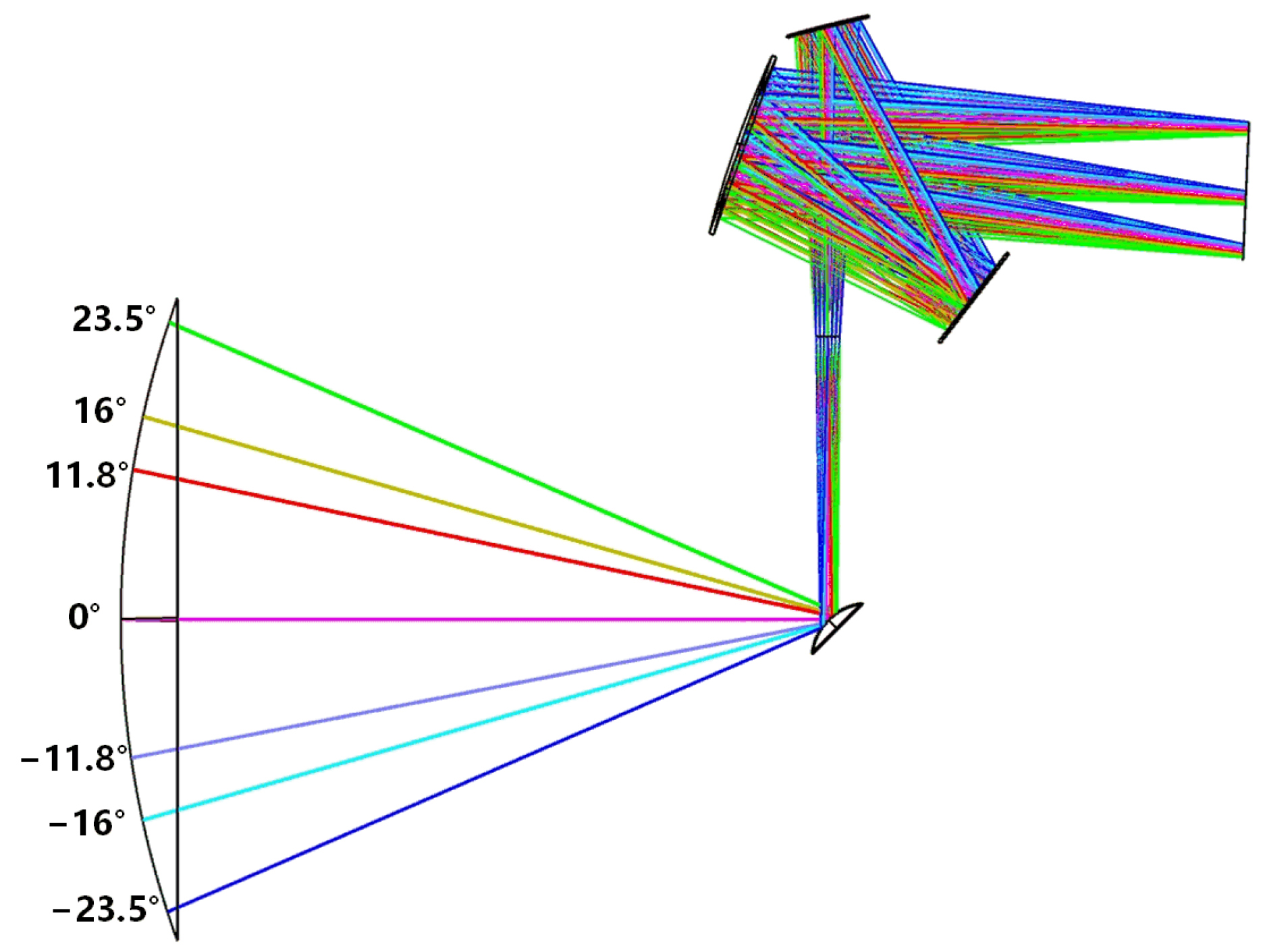
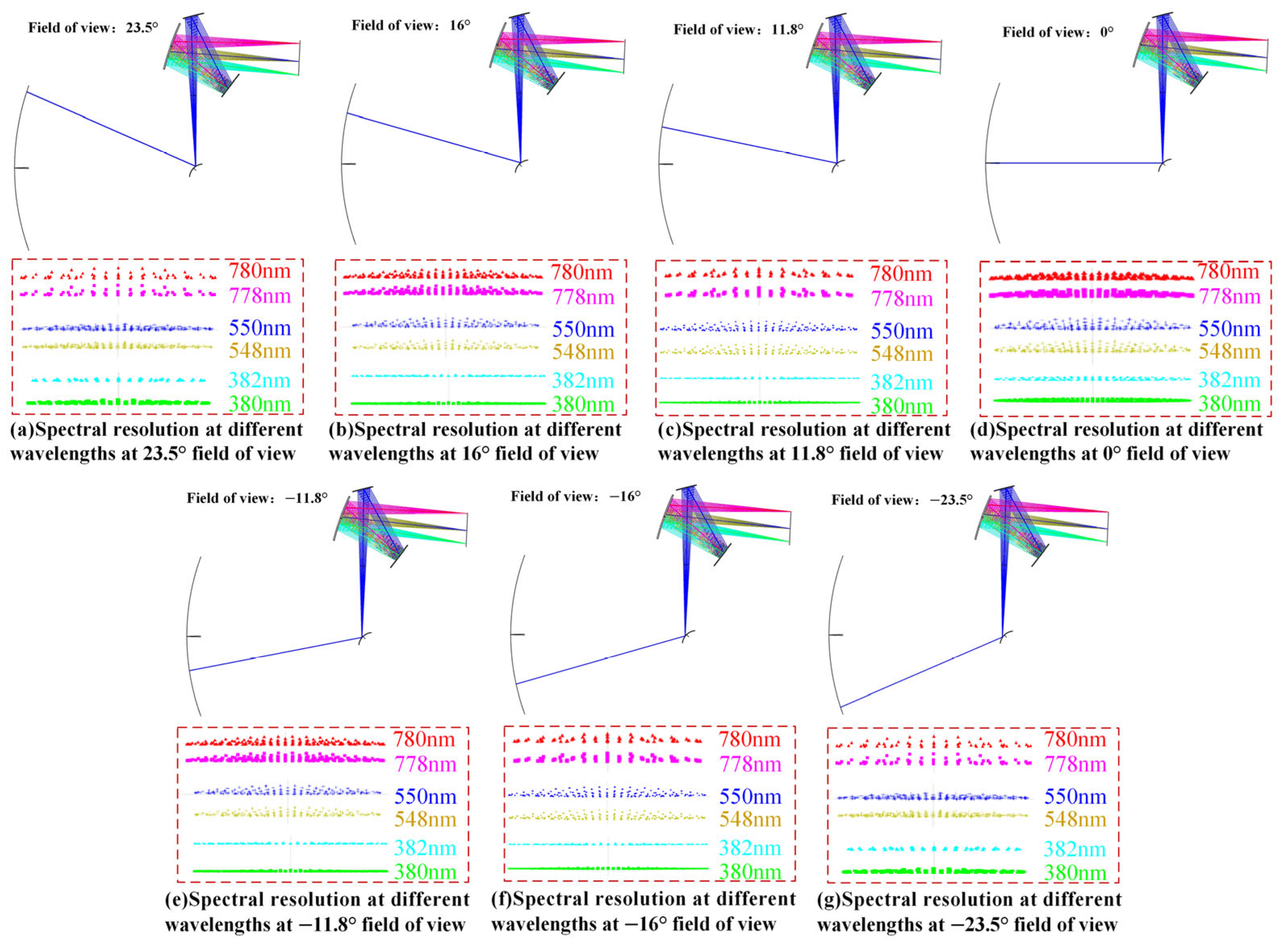
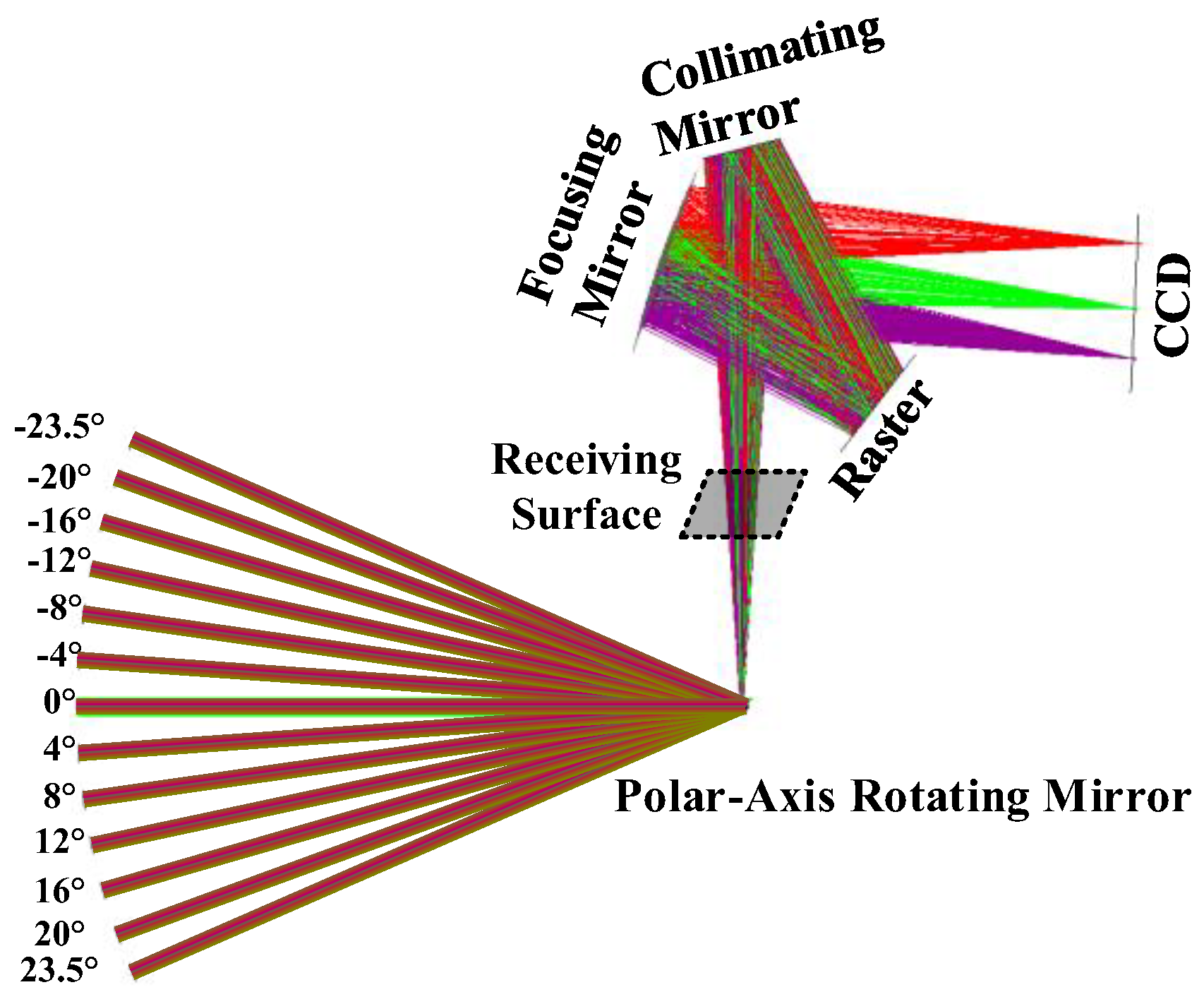




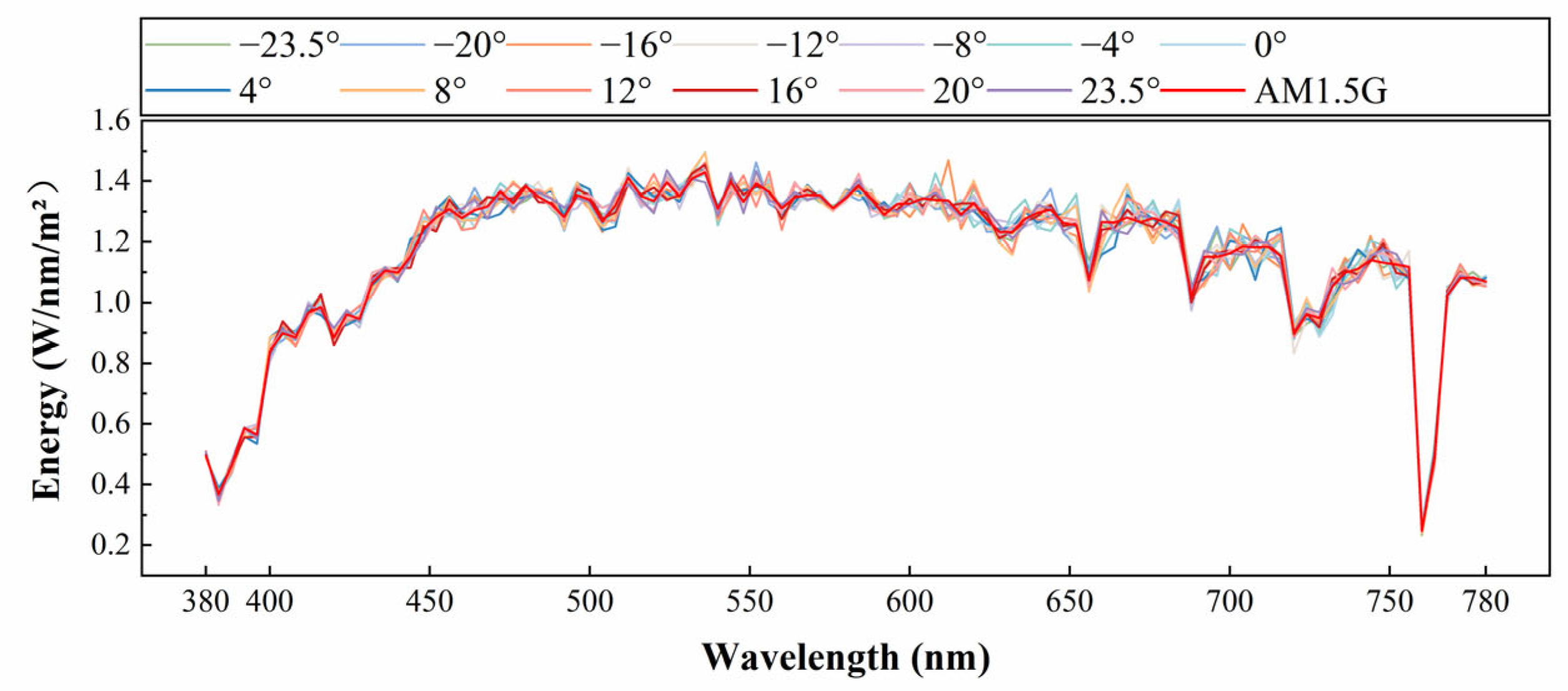

| Evaluation | Evaluation Criteria | AM0 Spectrum | AM1.5G Spectrum |
|---|---|---|---|
| Detailed evaluation | scope | −9.05% to 13.35% | −9.19% to 13.66% |
| 0° | −8° | ||
| 740 nm | 760 nm | ||
| /corresponding incident angle | 2.59%/8° | 2.86%/8° | |
| Overall evaluation | scope | −0.04% to 0.09% | −0.03% to 0.11% |
| 8° | 99.92% | ||
| Annual measurement accuracy evaluation | RFUS | 99.93% | 99.92% |
Disclaimer/Publisher’s Note: The statements, opinions and data contained in all publications are solely those of the individual author(s) and contributor(s) and not of MDPI and/or the editor(s). MDPI and/or the editor(s) disclaim responsibility for any injury to people or property resulting from any ideas, methods, instructions or products referred to in the content. |
© 2025 by the authors. Licensee MDPI, Basel, Switzerland. This article is an open access article distributed under the terms and conditions of the Creative Commons Attribution (CC BY) license (https://creativecommons.org/licenses/by/4.0/).
Share and Cite
Sun, J.; Zou, Y.; Wang, L.; Zhang, J.; Zhang, Y.; Zhang, K.; Su, Y.; Yang, J.; Zhang, R.; Zhang, G. Research on Polar-Axis Direct Solar Radiation Spectrum Measurement Method. Photonics 2025, 12, 931. https://doi.org/10.3390/photonics12090931
Sun J, Zou Y, Wang L, Zhang J, Zhang Y, Zhang K, Su Y, Yang J, Zhang R, Zhang G. Research on Polar-Axis Direct Solar Radiation Spectrum Measurement Method. Photonics. 2025; 12(9):931. https://doi.org/10.3390/photonics12090931
Chicago/Turabian StyleSun, Jingrui, Yangyang Zou, Lu Wang, Jian Zhang, Yu Zhang, Ke Zhang, Yang Su, Junjie Yang, Ran Zhang, and Guoyu Zhang. 2025. "Research on Polar-Axis Direct Solar Radiation Spectrum Measurement Method" Photonics 12, no. 9: 931. https://doi.org/10.3390/photonics12090931
APA StyleSun, J., Zou, Y., Wang, L., Zhang, J., Zhang, Y., Zhang, K., Su, Y., Yang, J., Zhang, R., & Zhang, G. (2025). Research on Polar-Axis Direct Solar Radiation Spectrum Measurement Method. Photonics, 12(9), 931. https://doi.org/10.3390/photonics12090931





